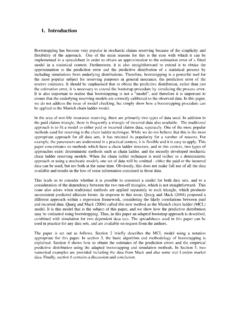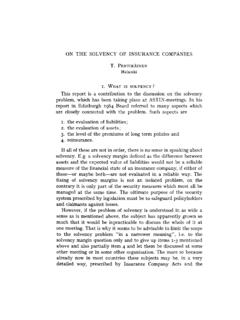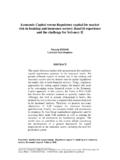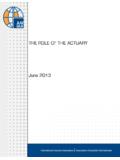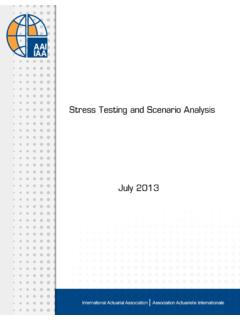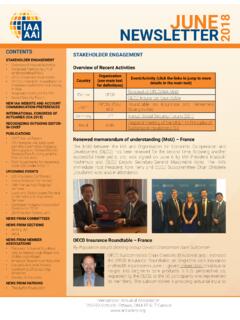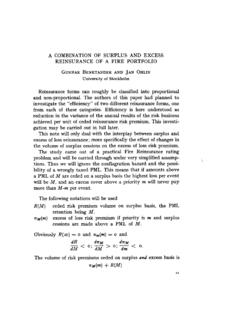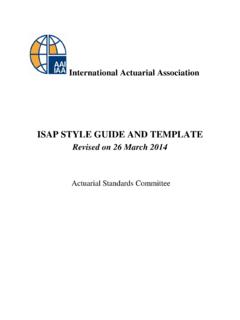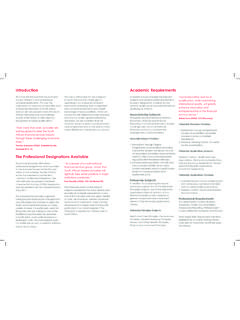Transcription of Loss reserving techniques: past, present and future
1 loss reserving techniques: past , present and futureGreg TaylorTaylor Fry Consulting Actuaries &University of MelbourneGrainne McGuireTaylor Fry Consulting ActuariesAlan GreenfieldTaylor Fry Consulting ActuariesEvolution of loss reserving models3 Overview Taxonomy of loss reserving models Evolution of such models through past to present Examination of one of the higher species of model in more detail Some predictions of future evolution4 Classification of loss reserving models Taxonomy of models Considered in Taylor (1986) Stochasticity Model structure Macro or Micro Dependent variables Paid losses or incurred losses Claim counts modelled or not Explanatory variables5 Classification of loss reserving models Research for subsequent book (Taylor, 2000) About half loss reserving literature later than 1986 New techniques introduced Revise classification?6 Classification of loss reserving models Major dimensions for modern classification Stochasticity Dynamism Model (algebraic) structure Parameter estimationDimen-sion2 Dimension 17 Classification of loss reserving models Typical trianglejiC(i,j) For the sake of the subsequent discussion, assume that we are concerned with a triangle of values of some observed claim statistic C(i,j) fori = accident periodj = development period8 Classification of loss reserving models -Stochasticity Stochastic model Observations C(i,j) assumed to have formal error structure.
2 C(i,j) = (i,j) + e(i,j)parameterstochastic error9 Classification of loss reserving models -Dynamism Dynamic model Model parameters assumed to evolve over timeE[C(i,j)] = (i,j) = f ( (i),j)parametervector (i) = (i-1) + w(i)stochasticperturbation10 Classification of loss reserving models Model (algebraic) structure Spectrum of possibilitiesPhenomenologicalMicro-struc turalModel fine structure of claims individual claims according to their own characteristicsModel descriptive statistics of the claims experience that have no direct physical chain ladder ratios11 Classification of loss reserving models Parameter estimation Two main possibilities Heuristic chain ladder Typical of non-stochastic models Optimal according to some statistical optimality criterion maximum likelihood12 Evolution of loss reserving models Phylogenetic treePhenomen-ologicalHeuristicDetermin-i sticPhenomen-ologicalHeuristicPhenomen-o logicalMicro-structuralOptimalStochastic StaticPhenomen-ologicalMicro-structuralO ptimalStochasticDynamicLoss reservingmodels13 Evolution of loss reserving models Main branches of phylogenetic
3 TreePhenomen-ologicalHeuristicDetermin-i sticPhenomen-ologicalHeuristicPhenomen-o logicalMicro-structuralOptimalStochastic StaticPhenomen-ologicalMicro-structuralO ptimalStochasticDynamicLoss reservingmodels14 Evolution of loss reserving models Main branches of phylogenetic treePhenomen-ologicalHeuristicDetermin-i sticPhenomen-ologicalHeuristicPhenomen-o logicalMicro-structuralOptimalStochastic StaticPhenomen-ologicalMicro-structuralO ptimalStochasticDynamicLoss reservingmodels15 Evolution of loss reserving models Main branches of phylogenetic treePhenomen-ologicalHeuristicDetermin-i sticPhenomen-ologicalHeuristicPhenomen-o logicalMicro-structuralOptimalStochastic StaticPhenomen-ologicalMicro-structuralO ptimalStochasticDynamicLoss reservingmodels16 Darwinian view Ascent of loss reserving models Earliest models (up to late 1970s) Chain ladder (as then viewed) Separation method (Taylor, 1977) Payments per claim finalised (Fisher & Lange, 1973.)
4 Sawkins, 1979) etcStaticDeterministicPhenomenologicalHe uristic17 Darwinian view Ascent of loss reserving models Any deterministic model may bestochasticisedby the addition of an error term If error term left distribution-free, parameter estimation may still be heuristic Stochastic chain ladder (Mack, 1993)StaticDeterministicPhenomenological HeuristicStaticStochasticPhenomenologica lHeuristic18 Darwinian view Ascent of loss reserving models Alternatively, optimal parameter estimation may be applied to the case of distribution-free error terms Least squares chain ladder estimation (De Vylder, 1978) Optimal parameter estimation may also be employed if error structure added Chain ladder for triangle of Poisson counts (Hachemeister & Stanard, 1975) Chain ladder with log normal age-to-age factors (Hertig, 1985) Chain ladder with triangle of over-dispersed Poisson cells (England & Verrall, 2002)StaticDeterministicPhenomenological HeuristicStaticStochasticPhenomenologica lHeuristicStaticStochasticPhenomenologic alOptimal19 Darwinian view Ascent of loss reserving models Insert finer structure into model Payments per claim finalised (Taylor & Ashe, 1983) Distribution of individual claim sizes at each operational time (Reid, 1978)StaticDeterministicPhenomenological HeuristicStaticStochasticPhenomenologica lHeuristicStaticStochasticMicro-structur alOptimalStaticStochasticPhenomenologica lOptimal20 Darwinian view Ascent of loss reserving models Parameter variation may be added by means of Kalman filter Payment pattern (by development year) model (DeJong& Zehnwirth, 1983) Chain ladder (Verrall, 1989)
5 StaticDeterministicPhenomenologicalHeuri sticStaticStochasticPhenomenologicalHeur isticStaticStochasticMicro-structuralOpt imalStaticStochasticPhenomenologicalOpti malDynamicStochasticPhenomenologicalOpti mal21 Darwinian view Ascent of loss reserving models Kalman filter may be bolted onto many stochastic models though with some shortcomings, to be discussedStaticDeterministicPhenomenolog icalHeuristicStaticStochasticPhenomenolo gicalHeuristicStaticStochasticMicro-stru cturalOptimalStaticStochasticPhenomenolo gicalOptimalDynamicStochasticMicro-struc turalOptimalDynamicStochasticPhenomenolo gicalOptimalAdaptive loss reserving23 Adaptive loss reserving By this we mean loss reserving based on dynamic models Kalman filter is an example Kalman,1960 engineering Harrison & Stevens, 1976 statistical De Jong& Zehnwirth, 1983 -actuarial We wish to generalise this24 Kalman filter -model System equation (parameter evolution) j+1 = Gj+1 j+ wj+1p 1 p p p 1 p 1parameter vector stochasticperturbation V[wj+1] =Wj+1 Observation equationYj = Xj j+vjn 1 n p p 1 n 1observation design parameter stochasticmatrix vector error V[vj] =Vj25 Kalman filter -operation Updates parameter estimates iteratively over time Each iteration introduces additional information from a single epoch26 Notation For any quantity Yjdepending on epoch j, letYj|k= estimate of Yjon the basis of information up to and including epoch k j|k= V[ j|k] = parameter estimation error27 Kalman filter single iterationForecast new epoch s parameters and observations without new information j+1|j =Gj+1 j|j j+1|j = Gj+1 j|j GTj+1 + Wj+1Yj+1|j = Xj+1 j+1|jCalculate gain matrix (credibility of new observation)
6 Update parameter estimates to incorporate new observationLj+1|j = Xj+1 j+1|j XTj+1 + Vj+1Kj+1 = j+1|j XTj+1 [Lj+1|j]-1 j+1|j+1 = j+1|j + Kj+1 (Yj+1-Yj+1|j) j+1|j+1 = (1 -Kj+1Xj+1) j+1|j28 Kalman filter parameter estimation updating Key equation j+1|j+1 = j+1|j +Kj+1 (Yj+1-Yj+1|j) Linear in observation Yj+1 Bayesian estimate of j+1if j+1and Yj+1normally distributed29 Kalman filter application to loss reserving The observations Yjare some loss experience statistics Yj= (Yj1,Yj2,..)TYjm= log [paid losses in (j,m) cell]~ N(.,.)E[Yj]= Xj j Paid losses are log normal with log-linear dependency of expectations on parameters ( De Jong & Zehnwirth, 1983)30 Kalmanfilter loss modelling difficulties Model error structureYj~ N(.,.) May not be suitable for claim count data Usually requires thatYjbe some transformation of loss statistics ( log) Inversion of transformation introduces need for bias correction Can be awkward31 Dynamic models with non-normal errors Kalman model System equation j+1 =Gj+1 j+wj+1 Observation equationYj =Xj j+vjvj~ N(0,Vj) Alternative model System equation j+1 =Gj+1 j+wj+1 Observation equationYjsatisfies GLM with linear predictor Xj jYjfrom exponential dispersion family (EDF)E[Yj] = h-1(Xj j) How should this be filtered?
7 32 Filtering as regression Kalman estimation equation j+1|j+1 = j+1|j +Kj+1 (Yj+1-Yj+1|j) Linear in prior estimate j+1|jand observation Yj+1 View as regression of vector [YTj+1, Tj+1|j]T on j+1Yj+1 = Xj+1 j+1 + vj+1 , V vj+1 = Vj+10 j+1|j1uj+1uj+1 0 j+1|j33 EDF filterKalmanfilterIdentityNormalYj+1 =h-1Xj+1 j+1 +vj+1 , Vvj+1 =Vj+10 j+1|j1 uj+1uj+1 0 j+1|jgenerally notdiagonalNon-identity EDFEDF filter34 FromKalmanto EDF filter iterationForecast new epoch s parameters and observations without new informationKalman filterCalculate gain matrix (credibility of new observation)Update parameter estimates to incorporate new observationOrdinary regression of augmented data vector on parameter vector35 FromKalmanto EDF filter iterationForecast new epoch s parameters and observations without new informationEDF filterCalculate gain matrix (credibility of new observation)Update parameter estimates to incorporate new observationGLM regression of augmented data vector on parameter vector36 FromKalmanto EDF filter iterationFor use of GLM regression softwareForecast new epoch s parameters and observations without new informationLinear transformation of estimated parameter vector to diagonal covariance matrixEDF filterCalculate gain matrix (credibility of new observation)
8 Update parameter estimates to incorporate new observationGLM regression of augmented data vector on parameter vector37 FromKalmanto EDF filter iterationForecast new epoch s parameters and observations without new informationCalculate gain matrix (credibility of new observation)Update parameter estimates to incorporate new observationGLM regression of augmented data vector on parameter vectorEDF filterLinear transformation of estimated parameter vector to diagonal covariance matrixFor use of GLM regression softwareSoftware performs this step38 EDF filter theoretical justification Approximate Bayes estimator Refer Jewell (AB 1974) Nelder& Verrall(AB 1997) Landsman & Makov (SAJ 1998)for the (exact) 1-dimensional case Stochastic approximation refer Landsman & Makov(SAJ 1999, 2003) for the 1-dimensional caseNumerical examples40 Example 1 Filtering rows of Payments per claim incurred Workers compensation portfolio Claim payments dominated by weekly compensation benefits Half-yearly data Consider triangle of payments (inflation corrected)
9 Per claim incurred in the accident half-year41 Example 1 Filtering rows of Payments per claim incurred Gradual changes in the pattern of payments are evident from one accident half-year to another42 Example 1 Filtering rows of Payments per claim incurredPPCI by accident half-year0500100015002000250001234567891 0111213141516171819202122232425developme nt half-yearPPCI89H290H194H298H243 Example 1 Filtering rows of Payments per claim incurred Model these changes with EDF filter Log link Gamma error Observation vectors = Rowsof triangle44 Example 1 Filtering rows of Payments per claim incurred Initiation of filter0500100015002000250012345678910111 21314151617181920212223242526development half-yearPPCI89H2 data89H2 fitted45 Example 1 Filtering rows of Payments per claim incurred Adding the next row of data050010001500200025001234567891011121 314151617181920212223242526development half-yearPPCI89H2 data89H2 fitted90H1 data46 Example 1 Filtering rows of Payments per claim incurred 90H1 posterior (fitted curve) developed from prior (89H2 fitted curve) and data050010001500200025000123456789101112 13141516171819202122232425development half-yearPPCI89H2 fitted90H1 data90H1 fitted47 Example 1 Filtering rows of Payments per claim incurred Continue this process for all rows.
10 Some more examples follow0500100015002000250001234567891011 1213141516171819202122232425development half-yearPPCI92H2 data92H2 fitted93H1 data48 Example 1 Filtering rows of Payments per claim incurred05001000150020002500012345678910 111213141516171819202122232425developmen t half-yearPPCI92H2 fitted93H1 data93H1 fitted49 Example 1 Filtering rows of Payments per claim incurred05001000150020002500012345678910 111213141516171819202122232425developmen t half-yearPPCI97H2 data97H2 fitted98H1 data50 Example 1 Filtering rows of Payments per claim incurred05001000150020002500012345678910 111213141516171819202122232425developmen t half-yearPPCI97H2 fitted98H1 data98H1 fitted51 Example 2 Filtering diagonals of claim closure rates Motor Bodily Injury portfolio From Taylor (2000) Annual data Consider triangle of claim closure rates:Number of claims closed in cellNumber open at start + 1/3 number newly reported in cell52 Example 2 Filtering diagonals of claim closure rates Claim closure rates subject to upward or downward shocks from time to time12345678910111213>13 Development year0%10%20%30%40%50%60%70%Closure rateExp yrs 1991-92 Exp yrs 1989-90 Exp yrs 1984-85 Claim closure rates53 Example 2 Filtering diagonals of claim closure rates Model these changes with EDF filter Identity link Normal error (Kalmanfilter) To be changed to binomial or quasi-Poisson Observation vectors = Diagonalsof triangle54 Example 2 Filtering diagonals of claim closure ratesi = accident year (row)j = development year (column)k = i+j = experience year (diagonal)C(j,k) = Claim closure rate55 Example 2 form of modelC(j,k) ~ N( (j,k), 2(j,k)) (j,k) = exp [f(j) + g(k)]Pattern of closure Upward or downwardrate over shock indevelopment yearexperience yearg(k)
